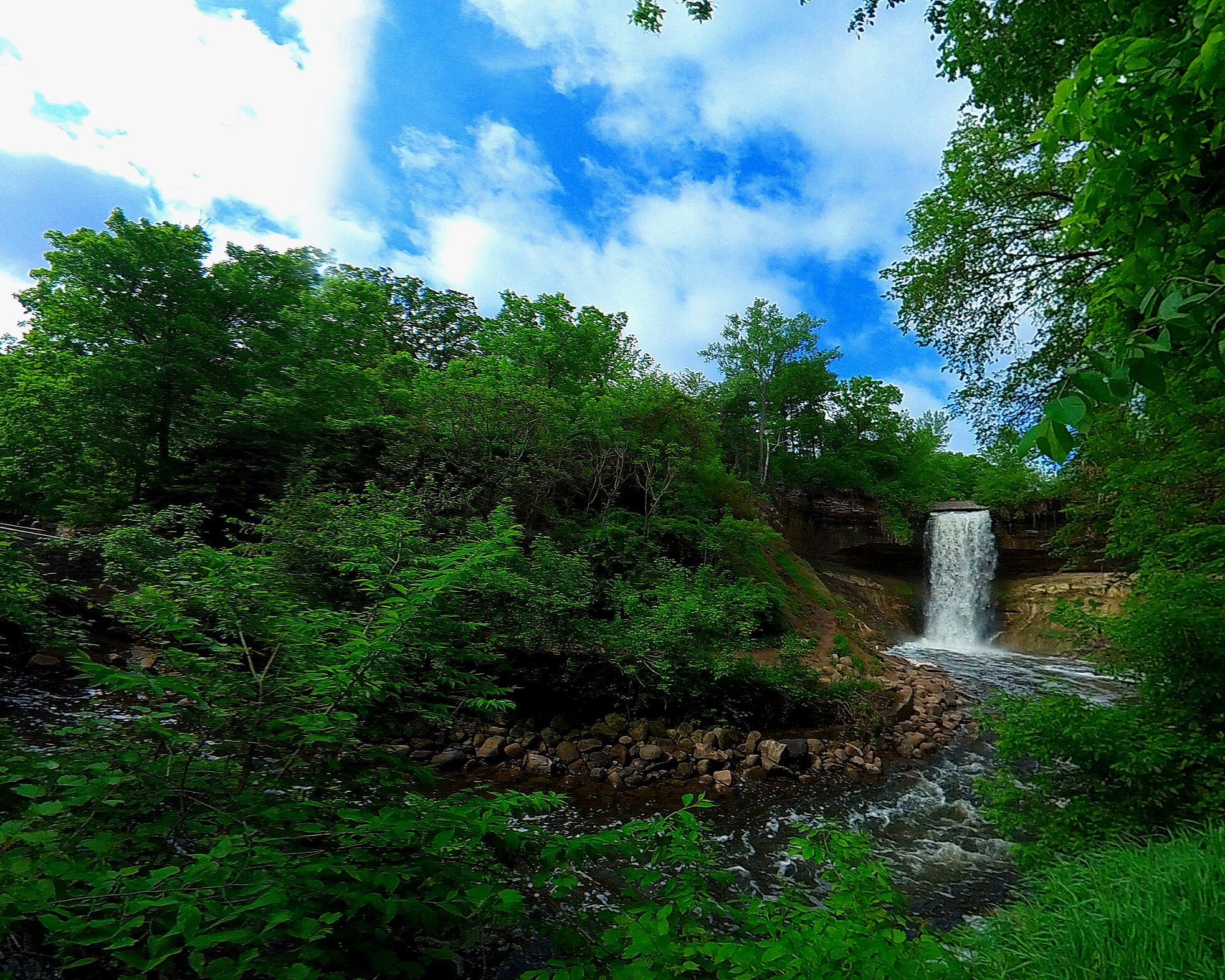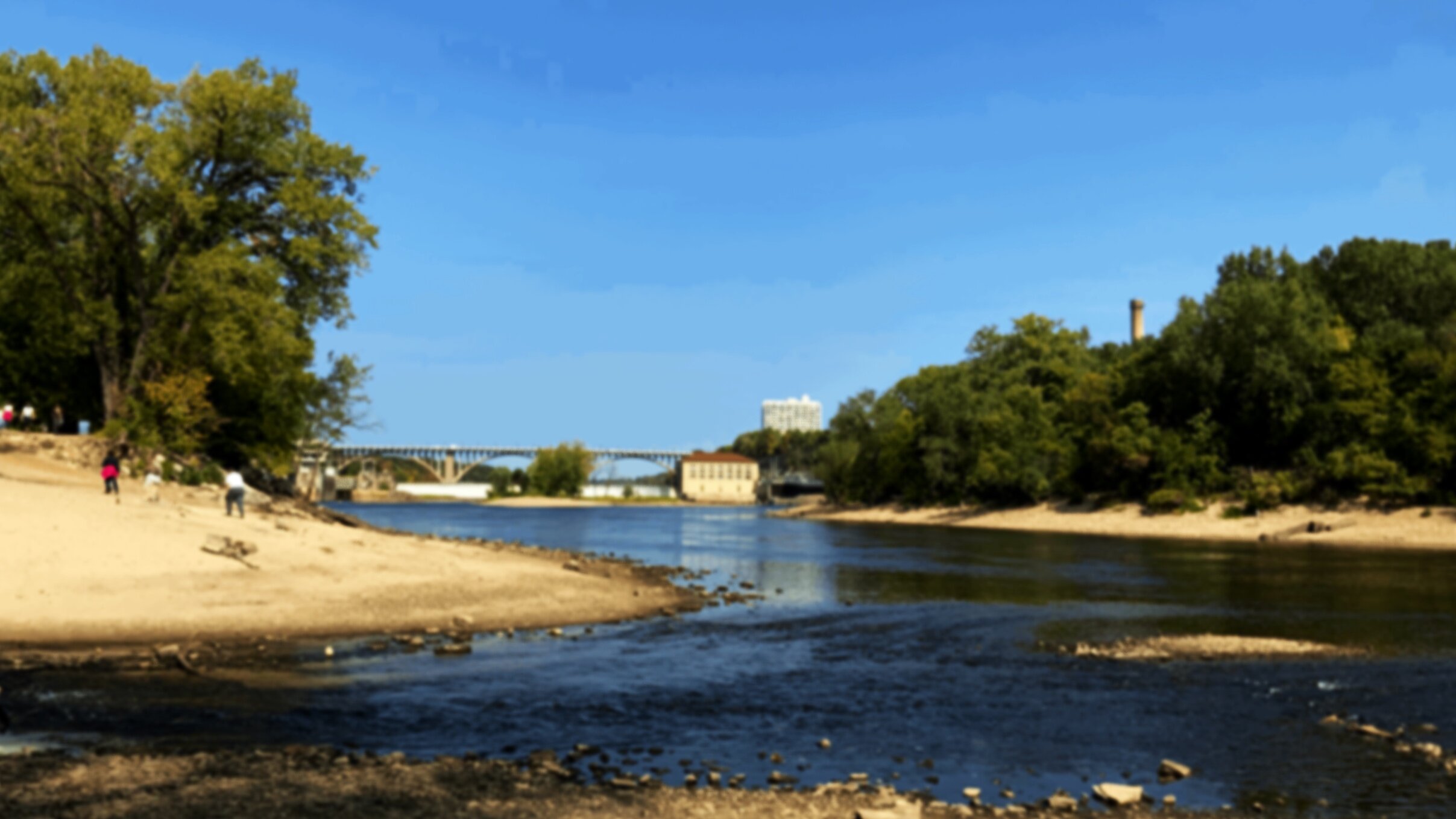
Sonic Augmented Reality (SonAR) II
Minnehaha Falls
An Immersive Audio Experience
SonAR (Sonic Augmented Reality) II is a “soundwalk” app offering users an immersive audio experience at Minnehaha Falls Park in Minneapolis. Scott L. Miller composed new music using the environmental sounds of Minnehaha Falls as inspiration for the public to interactively experience while on a self-guided walk through the park. The SonAR II app will be available to the public on June 25 through the Apple App Store and Google Play.
Experience Minnehaha Falls with a new and unique perspective. Using GPS, follow a map on the app with a recommended path and start location. With headphones in, you’ll hear Miller’s composition layered over the ambient sounds of the park while exploring the path. Your unique movement, Miller’s composition, and the sounds of the park, combine to create a unique experience.
It takes about 30 minutes at a comfortable walking pace to travel the recommended path, but can be as long or as short as you desire. You’ll best experience the intended layering of sound when wearing earbuds or headphones that allow ambient sound to come through (not noise cancelling headphones).
Watch a Preview of SonAR II
Download SonAR II
Get the free app for Apple and Android. Available June 25.
Minnehaha Falls
Visit the Minnehaha Falls in Minneapolis, MN to experience SonAR II.
“At the end of the soundwalk, the listener will have actively engaged with the park’s sonic ecology. Perhaps they’ll be newly aware of certain sounds or the reasons they exist. Perhaps they’ll simply question why the park sounds the way it does, or why they feel the way they do about the sound.”
— Scott L. Miller
Artist Statement
I wanted to find an iconic Minnesota location that is both conducive to walking and has an interesting sonic ecology. My daughter recommended Minnehaha Falls Park, and so I visited in September 2020 to conduct an initial listening walk. This involved walking various paths in the park, taking notes on a map of dominant acoustic phenomena, and recording the walk in stereo and 3D (using an Ambisonic microphone). Later I reviewed my notes and listened back to the recordings to identify soundmarks (sonic landmarks) and keynotes (the general tone or “key” of a sonic environment). I analyzed the audio recordings for sonic features that suggested listening to the environment as music, that evoked or inspired in me musical contributions I could make that complement the sonic ecology, or that would draw our attention to sonic features through imitation, tuning, and contrast.
At the start of the soundwalk, the sound of the Blue Line light rail and MN Highway 55 quickly give way to the dominant sounds of Minnehaha Falls. These geophonic sounds of falling and flowing water continue and are transformed by the changing shape of Minnehaha Creek as you follow the path. Eventually, as you approach the Mississippi River, where water dominates the landscape (riverscape), the soundscape is dominated by anthropophony, the sound of people talking and river boats.
And so it was water that inspired my approach to composing music for this soundwalk, and I began by creating sounds based on pizzicato strings, evoking the sound of rain drops falling in somewhat regular but still chaotic collections, pooling together. As you approach the top of the falls and descend the steps, you are gradually immersed in the sound of the falls as well as the composed sound of the app, multiple sources of plucked raindrop sounds. New sounds emerge and overlap as you move past the basin of the Falls and travel along the creek. Haunting choral voices enter (these a synthesized sound based on my own singing!) and gradually, the composed music recedes and you hear the rapid running water of the creek racing toward the Mississippi River.
I chose some natural locations to pause, such as where you find benches, to be silent—or nearly so—of my music. One of these locations is at Bridge 2. If you go to the middle of the bridge, you can distinctly hear a difference in the sound of the creek on the west-side compared to the sound when facing the east-side. This dramatic point in the local soundscape was important to me to preserve, rather than obscure.
The Soldier’s Home Bridge has very little traffic, and provides a relatively quiet shady spot to rest and listen to the intersection of a few different strands of my music that all converge in that space. Moving only a few meters in one direction or another can introduce new musical voices, while turning around to get a new view moves sounds from front to back, and vice versa.
In addition to the sound of the falls and the creek, I took inspiration from the sounds of our own making. It is possible to anticipate hearing, but not predict, certain sounds such as airplanes overhead, train crossing bells, bird songs, and bicycle tires on gravel. These sounds cross the boundary of the park’s natural sonic ecology, to become part of it. In much the same way, the park’s sonic ecology crosses the boundary of the listener’s headphones, to co-mingle with sounds of the app. In the right frame of mind, these can be heard not as noise, or an interruption, but as interesting features that emerge from the fabric of the sound of the environment and the sound of my music to form a new composition, unique to the moment.
As you travel closer to the Mississippi River, the sound of the music I composed is less active, less percussive, and more a fabric woven from many long tones. The sounds are in some cases quite synthetic in nature, being digitally pure, to contrast with the raw, organic quality of the natural soundscape. Other sounds are again drawn from the human voice. In the area near Bridge 5, which loops across and back around the Minnehaha Creek, there is a dense polyphony of individually simple sounds, which like the soundscape around you, combine to produce a more complex tapestry of sound.
Part of what makes this app effective at connecting the listener with the sonic ecology is anticipation. Having downloaded the app and put on headphones, the listener is prepared to hear something, but not necessarily what. And so, the listener is paying close attention to sound, actively listening and toggling between different modes or levels of listening attention. Composer and acoustic ecologist Barry Truax identifies “listening-in-search”—which I imagine is happening when first using the app—as the listener is waiting to hear evidence of my work, or evidence that the app is working at all. “Listening-in-readiness” is the other level of attention I think is activated by using the SonAR app. As the sounds of my composition and of the park’s sonic ecology become familiar, attention can be focused elsewhere, for example, on the water itself, the trees, or the path. If a change to what is heard occurs—a new sound, or noticing the absence of a sound—the ready listener becomes aware, and focuses on that change, perhaps the circumstances surrounding it. At the end of the soundwalk, the listener will have actively engaged with the sonic ecology, perhaps being newly aware of certain sounds or the reasons they exist, or even simply questioning why the park sounds the way it does and why they feel the way they do about the sound.
—Scott L. Miller
Project credits
Scott L. Miller, composer, sound design. Created with software engineering assistance from the SCSU Visualization and Simulation Lab, Directed by Mark Gill, and Marty Fitzer, Joshua Blair, Luigi Leuzzi, Thomas Schmidt, and James Vue.
SonAR II is supported by the Hellervik Award and St. Cloud State University.
Interview from May 2020: https://today.stcloudstate.edu/miller-earns-hellervik-prize
The technology used to create SonAR II:
Unity3D, a software platform for creating interactive, real-time games and apps
Symbolic Sound Kyma sound design workstation, with the Kyma Ambisonic Toolkit
Pro Tools Ultimate and Waves B360 and Ambisonic NX plugins






